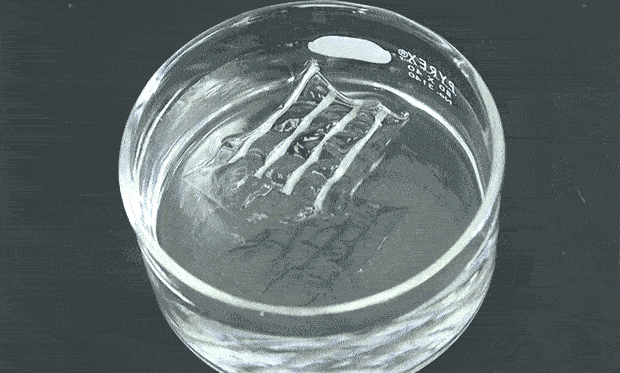Under the cover of night, enemy agents capture an elite solider unit. The agents hold down the commander and cut through the skin of his upper arm, pulling out a slim, transparent circuit board containing the unit’s military directives. But as soon as the agents remove the device, it dissolves before their eyes.
Sounds sci-fi, right? Yet such technology is one step closer to reality this month, thanks to a proof-of-concept study published in the journal ACS Applied Materials and Resources. A pair of engineers at Vanderbilt University has constructed simple circuit boards, including conductive traces and capacitors, that work above room temperature but rapidly disintegrate when cooled below 32°C (89°F).
There are numerous types of transient electronics in development, but many are designed to self-destruct when energy, such as heat or light, is applied. Others must be submerged in water. The novelty of this new technology is that simple neglect leads to destruction: When warm, the technology works; if not, it comes apart.
“It’s a little bit backwards of what people tend to think,” says senior author Leon Bellan, who develops micro/nanofabrication techniques for smart materials at Vanderbilt. “You have to provide heat to prevent it from dissolving.”
The system involves a series of silver nanowires held together by a polymer that is hydrophobic at room temperature or warmer, but hydrophilic at lower temps. Bellan, along with graduate student Xin Zhang, placed a simple circuit board made of these materials in a warm water bath, where it was able to turn on an LED light.
But when the engineers cooled the water bath, the board dissolved. The electronic components stopped working within seconds as the silver nanowires lost contact with each other, says Bellan. The whole thing disintegrated within a matter of minutes.
Bellan previously used the temperature-sensitive polymer as the raw material in a cotton candy machine. The machine spun a network of fine threads that dissolved once embedded in a hydrogel, leaving behind capillary-like microfluidic networks.
The self-destruct system does have a number of sci-fi applications, admits Bellan, such as our example of the solider with a device embedded in his arm. “If body heat were lost, because the solider was killed or because it was removed from the solider, it would immediately dissolve,” says Bellan.
There are also more mundane, but more near-term, applications of the tech. Metal nanoparticles have been widely studied in biomedicine and appear to be largely non-toxic and even anti-microbial. So it could be feasible to implant an RFID tag made with this technology into a hospital patient, or even livestock, as a way to track movements. Then, if a patient is released from a hospital or an animal sold, the simple application of a cold pack to the site of implantation would dissolve the tag.
Bellan’s group is now working to see if the circuit boards behave the same in tissue. (They’ve begun by embedding them in steaks. Yum.) They’re also building RFID tags into the material for wireless detection, and are working to construct devices that include transistors using semiconductors, says Bellan. “Once you start integrating more complex electronic components, then you start talking about circuits that do very interesting things.”
Megan Scudellari is an award-winning freelance journalist based in Boston, Massachusetts, specializing in the life sciences and biotechnology. She was previously a health columnist for the Boston Globe and has contributed to Newsweek, Scientific American, and Nature, among others. She is the co-author of a college biology textbook, “Biology Now,” published by W.W. Norton. Megan received an M.S. from the Graduate Program in Science Writing at the Massachusetts Institute of Technology, a B.A. at Boston College, and worked as an educator at the Museum of Science, Boston.



